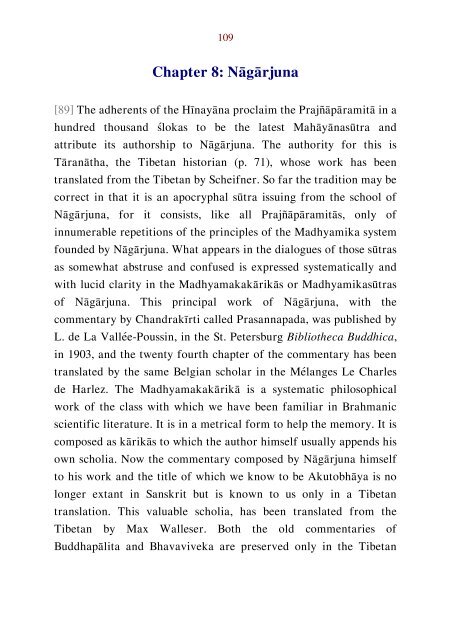Literary History of Sanskrit Buddhism
A study by J. K. Nariman of Sanskrit Buddhism from the Early Buddhist Tradition up to the Mahayana texts proper.
A study by J. K. Nariman of Sanskrit Buddhism from the Early Buddhist Tradition up to the Mahayana texts proper.
Create successful ePaper yourself
Turn your PDF publications into a flip-book with our unique Google optimized e-Paper software.
109<br />
Chapter 8: Nāgārjuna<br />
[89] The adherents <strong>of</strong> the Hīnayāna proclaim the Prajñāpāramitā in a<br />
hundred thousand ślokas to be the latest Mahāyānasūtra and<br />
attribute its authorship to Nāgārjuna. The authority for this is<br />
Tāranātha, the Tibetan historian (p. 71), whose work has been<br />
translated from the Tibetan by Scheifner. So far the tradition may be<br />
correct in that it is an apocryphal sūtra issuing from the school <strong>of</strong><br />
Nāgārjuna, for it consists, like all Prajñāpāramitās, only <strong>of</strong><br />
innumerable repetitions <strong>of</strong> the principles <strong>of</strong> the Madhyamika system<br />
founded by Nāgārjuna. What appears in the dialogues <strong>of</strong> those sūtras<br />
as somewhat abstruse and confused is expressed systematically and<br />
with lucid clarity in the Madhyamakakārikās or Madhyamikasūtras<br />
<strong>of</strong> Nāgārjuna. This principal work <strong>of</strong> Nāgārjuna, with the<br />
commentary by Chandrakīrti called Prasannapada, was published by<br />
L. de La Vallée-Poussin, in the St. Petersburg Bibliotheca Buddhica,<br />
in 1903, and the twenty fourth chapter <strong>of</strong> the commentary has been<br />
translated by the same Belgian scholar in the Mélanges Le Charles<br />
de Harlez. The Madhyamakakārikā is a systematic philosophical<br />
work <strong>of</strong> the class with which we have been familiar in Brahmanic<br />
scientific literature. It is in a metrical form to help the memory. It is<br />
composed as kārikās to which the author himself usually appends his<br />
own scholia. Now the commentary composed by Nāgārjuna himself<br />
to his work and the title <strong>of</strong> which we know to be Akutobhāya is no<br />
longer extant in <strong>Sanskrit</strong> but is known to us only in a Tibetan<br />
translation. This valuable scholia, has been translated from the<br />
Tibetan by Max Walleser. Both the old commentaries <strong>of</strong><br />
Buddhapālita and Bhavaviveka are preserved only in the Tibetan


















